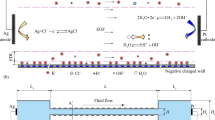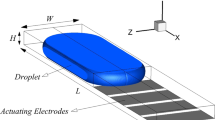Abstract
Computer simulation is used to investigate sample transport phenomena of cross microfluidic chips. In this study, Kirchhoff circuit theory is employed to calculate the electric field strength and approximate electroosmotic flow. It is apparent from the results that both the simulation and the theoretical data show similar trends in the electroosmosis of cross microchips. The main target in this study is to summarize the optimal controlling parameter values for avoiding sample leakage in the transport process. The effects of the applied voltage ratio, the geometry ratio and the zeta potential were simulated using a computational fluid dynamics and multiphysics solver software package (CFD-ACE+). Under our designed conditions, two major conclusions were reached: (1) for high-voltage ratios, the sample leakage can be avoided as the geometry ratio is large enough at 0.5 or greater, and (2) for small geometries, maintaining a smaller voltage ratio, 0.3 or less, is essential for avoiding sample leakage. The key is to govern the sample velocity in the upstream faster than that in the downstream. Although real experimental conditions can be further fine tuned under microscopy monitoring, these conclusions are helpful to design the proper channel geometry and set up suitable voltage parameters to avoid sample leakages in one cross-channel chip.







Similar content being viewed by others
References
Ermakov S, Jacobson S, Ramsey J (1998) Anal Chem 70:4494–4504. doi:10.1021/ac980551w
Manz A, Fettinger JC, Verpoorte E, Harrison DJ, Leid H, Widmer AM (1990) Tech. Digest MME 90. Berlin, pp 127–132
Ross D, Johnson TJ, Locascio LE (2001) Anal Chem 73:2509–2515. doi:10.1021/ac001509f
Devasenathipathy S, Santiago JG (2002) Anal Chem 74:3704–3713. doi:10.1021/ac011243s
Patankar NA, Hu HH (1998) Anal Chem 70:1870–1881. doi:10.1021/ac970846u
Arulanandam S, Li D (2000) J Colloid Surf A: Physicochem Eng Asp 161:89–102. doi:10.1016/S0927-7757(99)00328-3
Mala GM, Yang C, Li D (1998) J Colloid Surf A: Physicochem Eng Asp 135:109–116. doi:10.1016/S0927-7757(97)00215-X
Yang C, Li D (1998) J Colloid Surf A: Physicochem Eng Asp 143:339–353. doi:10.1016/S0927-7757(98)00259-3
Jacobson SC, Culbertson CT, Daler JE, Ramsey JM (1998) Anal Chem 70:3476–3480. doi:10.1021/ac980349t
Sinton D, Li D (2003) J Colloid Surf A: Physicochem Eng Asp 222:273–283. doi:10.1016/S0927-7757(03)00233-4
Arulanandam S, Li D (2000) J Colloid Interface Sci 225:421–428. doi:10.1006/jcis.2000.6783
Sinton D, Canseco CE, Ren L, Li D (2002) J Colloid Interface Sci 254:184–189. doi:10.1006/jcis.2002.8584
Sinton D, Ren L, Li D (2003) J Colloid Interface Sci 266:448–456. doi:10.1016/S0021-9797(03)00630-1
Sinton D, Ren L, Li D (2003) J Colloid Interface Sci 260:431–439. doi:10.1016/S0021-9797(02)00181-9
Hu Y, Werner C, Li D (2004) J Colloid Interface Sci 280:527–536. doi:10.1016/j.jcis.2004.08.011
Wang X, Wu J, Li D (2006) J Colloid Interface Sci 293:483–488. doi:10.1006/j. jcis.2005.06.080
Jin Y, Luo GA (2003) Electrophoresis 24:1242–1252. doi:10.1002/elps.200390160
Tsai CH, Yang RJ, Ta CH, Fu LM (2005) Electrophoresis 26:674–686. doi:10.1002/elps.200410032
Seiler K, Fan HZ, Fiurl K, Harrison DJ (1994) Anal Chem 66:3485–3491. doi:10.1021/ac00092a029
Ren CL, Li D (2006) J Colloid Interface Sci 294:482–491. doi:10.1016/j.jcis.2005.07.051
Ren L, Li D (2002) J Colloid Interface Sci 254:384–395. doi:10.1006/jcis.2002.8645
Xuan X, Li D (2005) J Colloid Interface Sci 289:291–303. doi:10.1016/j. jcis.2005.03.069
Jacobson SC, Ramsey JM (1997) Anal Chem 69:3212–3217. doi:10.1021/ac961093z
Zhang CX, Manz A (2001) Anal Chem 73:2656–2662. doi:10.1021/ac010138f
Ren CL, Li D (2004) Anal Chim Acta 518:59–68. doi:10.1016/j.aca.2004.05.018
Patankar SV (1980) Numerical heat transfer and fluid flow in series in computational methods in mechanics and thermal sciences. Mc-Graw–Hill, Toronto
Acknowledgments
This study was supported from National Science Council, Taiwan (NSC), National Chung Cheng University, and National Formosa University.
Author information
Authors and Affiliations
Corresponding author
Appendix: The Kirchhoff Theory Model
Appendix: The Kirchhoff Theory Model
In the cross-channel conduits in Fig. 1, the electric current in each channel follows the relationship
where I 1 is the current in the upper port of the vertical channel, I 2 is the current in both side channels, and I 3 is the current in the lower port of the vertical channel.
In a channel, the electric resistance (R *) is proportional to the channel length L and inversely proportional to the cross-sectional area (A) of channel. In Eq. 7, the constant ρ is the inverse of the bulk liquid conductivity κ.
The above equation can be rearranged to solve for the electrical potential of the downstream after the intersection. The cross biochip requires four electrodes to control the potential in the separation process. To calculate the potential at the cross part (V cross),
where L 1 is 0.5 mm, L 2 is 0.4 mm (left and right), L 3 is 1.5 mm and R is the channel cross-sectional area ratio A2/A1. When channel depth is not changed, the electric resistance of each channel is dependent on the channel width.
For an infinite rectangular channel, the Helmholtz–Smolouchowski equation was obtained as follows:
In Eq. 5, μ eo is the electroosmotic mobility
where ε is the electric permittivity of the solution, η is the viscosity, and ζ is the zeta potential.
In Eq. 12 under the same zeta potential the electroosmotic mobility (μ eo) is constant. However, Eq. 10 indicates that the electric field strength changes when the cross-sectional area varies in different channel width ratios. Therefore, according to Eq. 11 the electroosmotic flow velocity (V s) changes when the channel width ratio varies.
Rights and permissions
About this article
Cite this article
Yang, MH., Wang, SC. & Cheng, JC. The Optimal Control of Geometry and Voltage Parameters on Electrokinetic Transport to Avoid Sample Leakage in Microfluidic Chips. Chromatographia 73, 567–577 (2011). https://doi.org/10.1007/s10337-011-1933-6
Received:
Revised:
Accepted:
Published:
Issue Date:
DOI: https://doi.org/10.1007/s10337-011-1933-6




